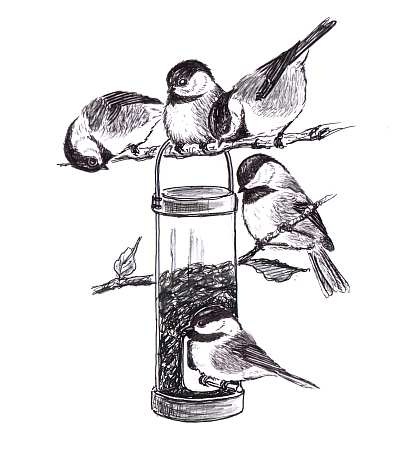
Dear Bird Folks,
I’ve noticed that some of the birds on my feeder love to sit and eat, and eat, and eat. Then there are other birds that will only take one seed and fly away. What causes the difference in feeding behavior? Are some birds greedy or simply hungrier than others?
– Helene, Monument Beach, MA
They are polite, Helene,
The birds that don’t eat and eat and eat are polite. Well, not really, but I used to have a customer who decided that chickadees were “polite birds” because they typically take only one seed and go. He wasn’t happy when I didn’t agree with him. I didn’t disagree about the chickadees taking only one seed, because for the most part that is true. What I couldn’t agree with was the part about chickadees being polite. Chickadees have a lot of good things going for them; so if any bird would have proper dining etiquette, it would be them. But the real reason they only take one seed at a time is to keep from being beaten up. How’s that for opening drama?
Birds have a variety of feeding behaviors, depending on their physical abilities and which feeding niches they are able to exploit. Some birds like to feed in dense flocks. The more the merrier works for these birds. The sounds of bills snapping and loud chirping, along with a bit of pushing and shoving, like the buffet line on cruise ship, makes these birds feel comfortable and safe while they are eating. Other birds have no use for the flock. Like the guy sitting at the end of the lunch counter, these birds want to be left the heck alone when they eat. They don’t need or want to be in a crowd. Last are the birds that are like people who live in an apartment complex. They like to eat alone, but still have others fairly close by. These birds feed in what is called, “loose flocks.” Chickadees are in this last group.
Birds that feed in flocks typically take advantage of a food source that is either unpredictable or is only available for a short period. A flock of gannets diving on a school of fish don’t have the luxury of eating the fish over an extended period. They have to eat as much as they can as quickly as they can because the fish may soon dive deeper, or be hauled up by a Russian trawler.
Birds such as the Belted Kingfisher, have no use for flocks. They can totally take care of themselves and are not into all the hysteria that comes with mass feeding. They are quite content to sit alone, over a quiet stream, and wait for the occasional fish to swim past. Except for the breeding season, kingfishers are all about dinner for one. Like the grumpy old hermit, who sits on the front porch with a shotgun, the kingfisher is not about to let a neighbor enter its territory, even for a visit. The aggressive bird knows that it may not have enough fish to spare and will meet intruders with a response that makes hermits and their shotguns seem peaceful.
Right now, Helene, you may wondering what diving gannets and feisty kingfishers have to do with your bird feeders. You know, I’m starting to wonder about that myself. Where was I going with all this? Oh, yeah. Now I remember.
Feeder birds also fit into the above categories. Goldfinches, for example, are flockers. They feel quite safe eating at a feeder with twenty of their closest friends. It doesn’t upset them in the least that another goldfinch is eating just inches away. Downy Woodpeckers, on the other hand, are bird feeder loners. If more than one downy arrives at a feeder at the same time, things will get ugly fast.
This brings us back to our pals, the chickadees. Chickadees really like each other’s company, but not enough to share their food. Within every flock there are dominant chickadees. The most dominant birds are usually the older males (how unusual). When a chickadee lands on a feeder, it may only have a second to grab a seed before a dominant bird flies in and chases it away. The chickadee that takes one seed and flies off isn’t being polite; it’s keeping itself from getting a whoopin’.
There is one other reason why chickadees, (as well as titmice and nuthatches) take one seed and go. Unlike finches and cardinals, which can bust open a seed in a single bite, or larger birds that can swallow seeds whole, the chickadees’ bills aren’t designed for cracking seeds. They must hammer their seeds open. And while they are busy hammering, they have their heads down and can’t watch for danger. By taking a seed to a less exposed location, they can hammer it open in relative safety… and avoid becoming lunch themselves.
The manner in which birds eat at a feeder isn’t determined by greed or hunger, Helene, but by which feeding methods each particular species has used successfully over the centuries. There is no greed in the world of birds; they leave that for the Russian trawlers.